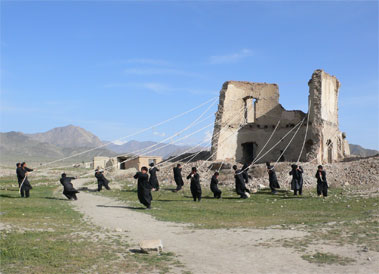EXHIBITION
12 JUN - 01 SEP 2015
WYSPA INSTITUE OF ART-GDANSK
Verncularity
Alternativa 2015

What we saw upon awakening, Lida Abdul 2006
Alternativa 2015 entails and develops ideas undertaken for a two-year project Garden of Everyday Errors
The project follows tacit knowledge in the practice of everyday life and in forms we tend to overlook. Our aim is to reverse this perspective. In this project the common form pierces or consumes the artistic one. We try to re-evaluate the ordinary and take it as a source of knowledge that has remained useless since we handed our lives over to the experts.
The program of the International Visual Arts Festival Alternativa 2015 is made up of the major exhibit Vernacularity, accompanied by a performative programme, an exhibition of the collective Hard-Core, three book publications and a continuation of Open Garden by Lendlabor which is further enriched by a participatory programme. Although we have prepared two exhibitions, most of the accompanying events allow themselves to nearly disappear in the hustle and bustle of everyday activities: while eating, walking, finding things alongside the road or working in the garden – all of which are often referenced in Vernacularity.
Open Garden was created from scratch last year with people from our neighbourhood in collaboration with the artists, architectural students and local botany enthusiasts. It is a demonstration of our tactic to regain the living space of the site that had seemed to be in the process of disintegration. We invite you to visit our garden and take part in our gardening chores, meetings and lectures. We will eat what we grow. We will get to know the artists for whom feeding and hunger are sources of research and happenings. We will also depart from here for field trips, watch movies and meet our guests.
The Vernacularity exhibition is planned for the entire summer. Until the end of September it remains our alphabet of everyday phenomena, a field of reference, a reservoir of forms and techniques. Vernacular is perhaps not a very popular term although it refers exactly to that which is common. It refers to the indigenous, to the language of daily communication, local knowledge, technology and a mode of representation. Today we speak of vernacular architecture, such as photography or graphic design. Vernacularity was chosen as the theme of our main exhibition which allows for a labyrinth of material works, paintings, sculptures, textiles, video and diverse activities linked to the objet trouvé , natural objects, techniques and technologies of the everyday, as well as quotidian substances and activities. It puts together the visual vocabulary of the common, reveals the links between the domestic and the relational.
Our matter of concern and inquiry are natural findings such as plants or stones; and the aesthetics of found objects as well as their ability to generate new forms; the painterly skills of the nail specialist and the anonymous talents of weavers. We are interested in vernacularity in photo representations and repetition in everyday chores. We refer to language, to what is translatable and untranslatable in a local context. This is perhaps due to it being untranslatable, often considered as a disqualifying aspect of work in the international circulation of art, as being a powerful generator of forms.
For August we have planned an exhibition by a group of artists working under the name Hard-Core as a counterweight to the curated exhibition. Prepared collectively, the presentation of the projects, on how to be liberated from the dominance of ideas and entrust it to an algorithm that calculates technical parameters and dimensions, is a pragmatic operator of the pieces in the exhibition. This digital, technological and anti-curatorial project operates in a reality parallel to the other, diligent, laborious and material part of the festival.
Garden of Everyday Errors: Vernacularity entails its sister project from the previous year: Everydayness and clasps together the five-year long programme line of Alternativa, tracing substantial phenomena from a local context such as labour and leisure, estrangement, materiality, utopian thinking and the tactics of everyday life. It is dedicated to occasionally noticed forms which are so unremarkable that they are nearly exceptional.
Please feel welcome not only to the exhibitions but also to actively participate in the overall programme. See you soon!
The artists list includes: Sherko Abbas Abdl-razaq, Lida Abdul, Alice Aycock, Babi Badalov, Ismail Bahri, Ricardo Basbaum, berszmisiak, Olaf Brzeski, Karolina Brzuzan, Rafał Bujnowski, Adelita Husni Bey, Monica Bonvicini, Latifa Echakhch, Harun Farocki, Esther Ferrer, Anton Kats, Daphne Keramidas, Anna Królikiewicz, Julie Luzoir, Wendelien van Oldenborgh, Agnieszka Polska, Simon Pope, Konrad Pustoła, Tere Recarens, Maciej Salamon, Mierle Laderman Ukeles, Florian Zeyfang, Sylvie Réno. HardCore. Lendlabor Open Garden: Lisa Enzenhofer & Anna Resch.
Share










